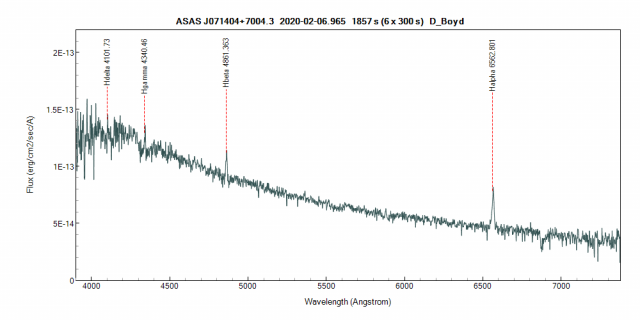› Forums › Variable Stars › Help monitor suspected cataclysmic variable star
- This topic has 1 reply, 2 voices, and was last updated 5 years, 10 months ago by
 David Boyd.
David Boyd.
-
AuthorPosts
-
7 February 2020 at 3:29 am #574523
 Jeremy ShearsParticipant
Jeremy ShearsParticipantBoris Gaensicke (University of Warwick) has requested help in monitoring a candidate cataclysmic variable, in support of his upcoming star run run (see below for more details). The star is called ASAS J071404+7004.3.
Initially, he is asking for a few snapshots per night to monitor for outbursts/gross variability. If we see that it varies a lot between those observations, we can go for a longer runs. Single-filter (V) observations are requested, but otherwise Clear if you have no filter.
It’s rather bright, between mag ~11.3 and 12.1. At present there is no sequence, but AAVSO VSP has some comparisons about 30 minutes away.
Position: 07 14 04.66 +70 04 18.4 (J2000.0) in Camelopardalis.
Jeremy Shears
________________________________________
From Boris’s message:
Two of my final year project students are exploring various ways to combine Gaia and GALEX to identify CV candidates, and one that they sent me is ASAS J071404+7004.3, an F/A type star that has a remarkably variable light curve, though not periodic. It looks like it has a UV excess, and so I am wondering if the variability are dwarf nova outbursts? The system could be similar to V1129 Cen, a very long-period (21h) CV, see https://ui.adsabs.harvard.edu/abs/2017NewA…57…51B. The brightenings have time scales of ~10 days, and given how bright the star is, it looks like a good target for a short intense campaign, trying to resolve the shape of the variability. We have some time on the INT coming up soon, and will get optical spectra, probing for emission lines, and RV variations.
Cheers, Boris
7 February 2020 at 11:23 am #582014 David BoydParticipant
David BoydParticipantA low resolution spectrum taken last night with a C11 + LISA spectrograph confirmed it is likely to be a CV with a strong blue continuum and Balmer emission lines. Clouds prematurely terminated the run after 30 mins. Concurrent B and V band photometry showed variation of ~0.08 mag possibly caused by flickering in the accretion process. B-V colour index is 0.075. The concurrently recorded mean V band magnitude was used to flux calibrated the spectrum.
David

-
AuthorPosts
- You must be logged in to reply to this topic.
